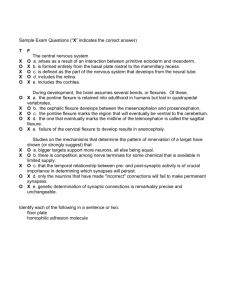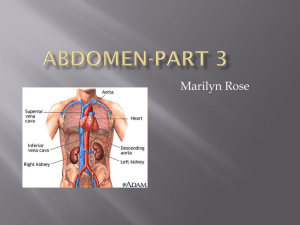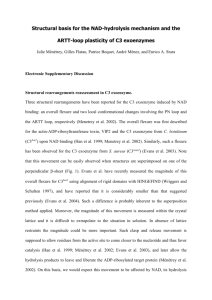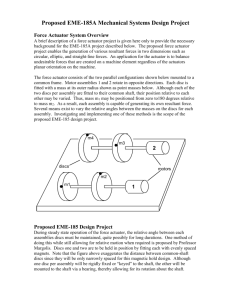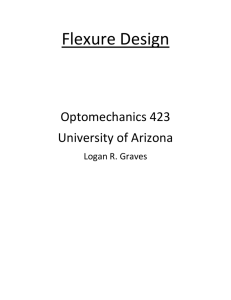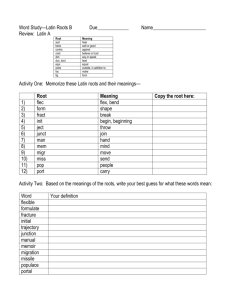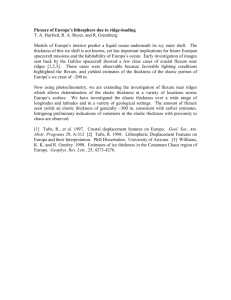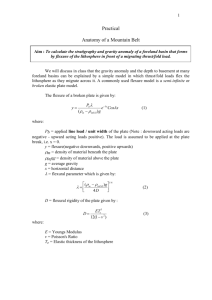Design and Testing of an Improved Animatronic Toy ... by Jacob M. Muhleman
advertisement
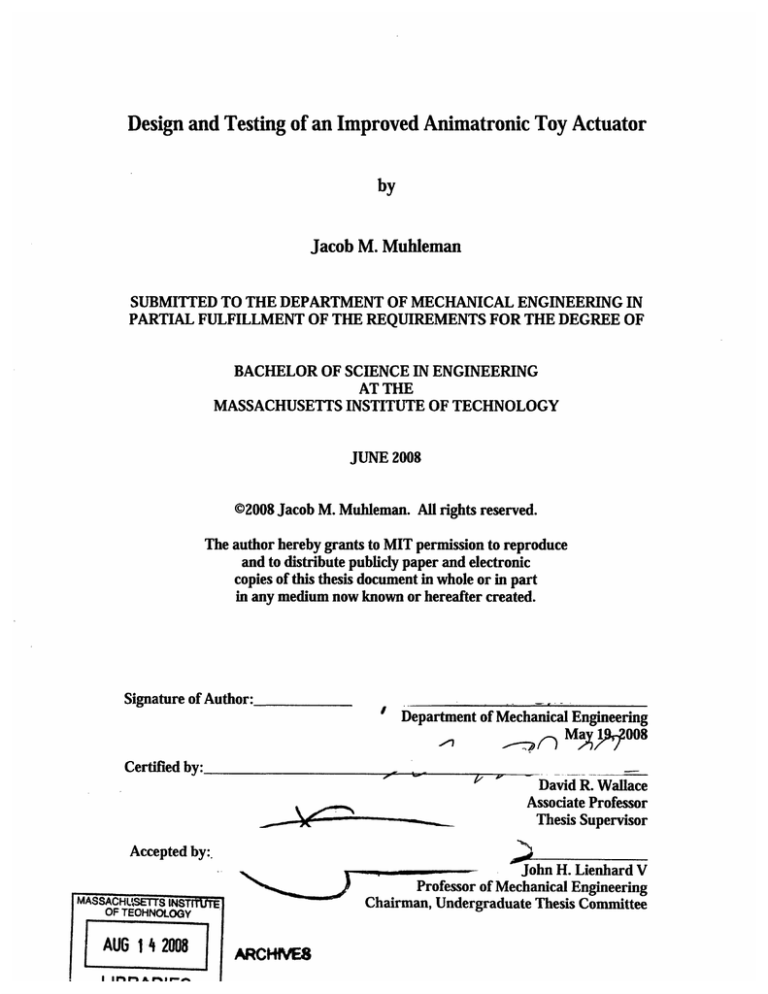
Design and Testing of an Improved Animatronic Toy Actuator by Jacob M. Muhleman SUBMITTED TO THE DEPARTMENT OF MECHANICAL ENGINEERING IN PARTIAL FULFILLMENT OF THE REQUIREMENTS FOR THE DEGREE OF BACHELOR OF SCIENCE IN ENGINEERING AT THE MASSACHUSETTS INSTITUTE OF TECHNOLOGY JUNE 2008 ©2008Jacob M. Muhleman. All rights reserved. The author hereby grants to MIT permission to reproduce and to distribute publicly paper and electronic copies of this thesis document in whole or in part in any medium now known or hereafter created. Signature of Author: Department of Mechanical Engineering 008 Ma ,nM( ~ -1 Certified by: ; ~4rr~rz~c %- -, ~ David R. Wallace Associate Professor Thesis Supervisor Accepted by:. -John H. Lienhard V Professor of Mechanical Engineering Chairman, Undergraduate Thesis Committee MASSACHL•STTS INSTUTE OF TEOHNOLOGY AUG 14 2008 LIBRARIES ARCHWVE Design and Testing of an Improved Animatronic Toy Actuator by Jacob M. Muhleman Submitted to the Department of Mechanical Engineering on May 19, 2008 in partial fulfillment of the requirements for the Degree of Bachelor of Science in Engineering as recommended by the Department of Mechanical Engineering ABSTRACT This thesis contributes to the development of a new type of actuator for use in robotic toy automation. The work covers an incremental series of experiments that examine, analyze, prototype, and test various ideas for converting the vibration of a voice coil into rotational motion. In its final form, it is believed that this actuator will provide a lowspeed, high-torque output using a single unit, eliminating the need for external gearing. Currently, such motion is actuated by direct current motors equipped with gear boxes that are both noisy and bulky. This new type of actuator will function more quietly, using a frequency lower than humans' sensory threshold for sound while making the movement of robotic toys more life-like when used to imitate animals. Furthermore, by using relatively inexpensive voice coils, this new type of actuator will potentially be less expensive to manufacture than currently used motors, and bring toys one step closer to accurately representing real life forms. The current prototype has some of the characteristics desired in a DC motor replacement, exhibiting a relatively high output torque and low angular velocity. However, the power output is much smaller that what would be useful. Also, the current prototype is larger than what would be useful in most animatronic toys. Future testing will need to address these issues in order to make the actuator into a viable product. Thesis Supervisor: David R. Wallace Title: Associate Professor -3- Table of Contents 1.0 Introduction ................................................................................................................... 7 1.1 Actuator Concept ............................................................................................. 8 1.1.1 Flexures..................................................................................................... 8 1.1.2 V oice Coil .................................................................................................... 9 1.2 Starting State of the Project ...................................... 9 1.2.1 Frictional Interface M odel ................................................... 10 1.2.2 Fixed Interface Model........................................................................... 11 2.0 M ethods ............................................. 2.1 Resonant Frequency............................................ 13 .............................................. 14 2.2 Design Variables..................................................................................................... 16 2.2.1 Flexure Type .................................................................................................... 16 2.2.2 Rotational Rectification ..................................... ...................... 17 2.2.3 Flexure Angle.............................................. ............................................... 21 2.2.4 Flexure Shape.............................................. ............................................... 23 2.3 Quantification of Param eters ..................................... .....................24 2.3.1 Bi-stable M odes of the Flexure.............................. ...................25 2.3.2 Quantitative Results .............................................................................. 3.0 Conclusions.................................... ....................................................................... 3.1 Future Steps .................................................................................................... .. 27 30 30 1.0 Introduction Presently, toys on the market leave much to be desired. They are not very life-like, especially in sounds and motion. Current actuators are loud because they use high speed, direct current (DC) motors equipped with bulky gearboxes. Professor David Wallace, director of the MIT Toy Lab, along with graduate student James Penn, came up with the basic concept of the new type of actuator as a potential improvement compared to those actuators used in the market today. I worked on this project under the supervision of Wallace and Penn to help develop a quieter, more efficient actuator. This new actuator is intended for robotic toy products similar to those currently on the market, including Furby and the FurReal Friends toy series, like the robotic pony shown in Figure 1. Figure 1: Left: The Hasbro Robotic Pony, Butterscotch [1] Middle: Actuator from pony Right: Actuator from pony (cover removed) -7- Inside the pony, there is a complex system of cams and gearing attached to a small DC motor. Elimination of this gear train would decrease the total number of parts and make the system more compact. A successful product would incorporate the function of a DC motor and gearbox into a single discrete actuator, while decreasing the amount of sound produced by the system. 1.1 Actuator Concept 1.1.1 Flexures The fundamental idea behind the actuator concept is to convert the vibration of a voice coil into useful rotational movement through the use of flexures. The central mechanism of the flexures is demonstrated in Figure 2. A flexure is attached to the bottom of a vertically constrained block. When a speaker membrane pushes up against the flexure, the frictional constraint on the tip forces the block to move horizontally. ixea aue to friction Figure 2: Movement due to flexures When these flexures are arrayed tangentially around a disk, the horizontal movement becomes a rotational displacement. This arrangement is pictured in Figure 3. Figure 3: Bottom view: flexures arrayed around a disk [2]. 1.1.2 Voice Coil The voice coil will be run at a frequency of approximately 20 Hz, below the range of human hearing, ensuring that the speaker itself does not make any discernable noise. The possible existence of significant harmonics also needs considered. In the prototype's current state, there is the existence of some noise that will have to be eliminated in the final product. A working prototype could potentially be developed into a product that could be easily manufactured. The product's small size would allow it to achieve the torques and angular velocities necessary for mechatronic toy actuation without requiring a gear box. 1.2 Starting State of the Project Upon entering this project, two main concept models, one with a frictional interface and one with a fixed interface, had been built to demonstrate that this type of actuator was possible. In both of these models, as well as ones used in this project, a 3.5 n, 3 W speaker with a two inch cone was used. 1.2.1 Frictional Interface Model The first model consists of an aluminum disk on the end of a shaft with a roller clutch to allow rotation in one direction while preventing it in the other. A flexure, made from water-jet spring steel with arms bent downwards (like that in Figure 3), was glued to the bottom of the disk. When placed on a speaker membrane covered with a thin piece of rubber, the movement of the flexure causes a slight rotation with each up-and-down movement. Friction holds the flexure and the speaker membrane together when contact first occurs. As the membrane moves farther up, the friction prevents the flexure from slipping. When the flexure bends, it is translated into a slight rotation. When the membrane retracts, the flexure is able to slip relative to the rubber membrane as the tip of the flexure does not dig into the rubber due to both its shape and the restriction of the shaft due to the one way clutch. This model serves as a good proof of concept [2]. Figure 4 shows an exploded solid model of the testing setup. Figure 4: Exploded view of testing setup. The large bar is attached to a speaker with the use of bolts, the roller clutch can be seen in the middle of the shaft, as well as a brass bushing used to vertically constrain the shaft. The flexure is mounted on the bottom of the disk found in the lower part of the image and rests on the speaker membrane [2]. -10- The trouble with this first setup is that it relies completely on friction for its torque output. This particular model has a relatively low output torque, exemplified by the ability to stop the shaft with your fingers. A better frictional interface will need to be developed if this model is pursued further. In addition, this friction has the potential to wear down the rubber or the speaker membrane itself, limiting the lifetime of the actuator. 1.2.2 Fixed Interface Model In the next iteration to improve the actuator, a new model was made using a flexure that did not require the use of friction. Instead, it consists of a single piece of Delrin that rotates slightly when the rim is depressed, as can be seen as a slight clockwise rotation in the middle pictures of Figure 5. Figure 5: Left: Fixed interface flexure Upper Middle: Flexure while not depressed Lower Middle: Flexure while depressed Right: Flexure assembly mounted on speaker -11- In this particular fixed interface model, the outer rim of the flexure is permanently affixed to the speaker membrane, allowing only the center of the flexure to move relative to the membrane. Similar to the previous model, the rotation due to the flexure is allowed in one direction and prohibited in the other. In this model, this is achieved by the use of two roller clutches. One is press fit into the center of the flexure, forcing the shaft to turn when moved in one direction and allowing it to freely spin in the other. The second roller clutch is positioned in the same orientation as the first to prevent the shaft from backturning as the flexure returns to its original position. This clutch is fit into the assembly above the flexure, hereby constraining the shaft and holding the proper starting angle for the flexure (Figure 6). Brass System Figure 6: This figure, a cross-section of the fixed interface model, shows the placement and orientation of the roller bearings to achieve counterclockwise motion. The dots show that shaft motion is allowed out of the page, whereas the X's allow motion into the page. To achieve clockwise motion, the direction of both would have to be reversed. This model serves to reinforce the proof of concept. However, in order for the actuator to be able to be developed into a successful prototype, it will have to exhibit proper characteristics of an actuator in a toy: low angular velocity, high torque, minimal sound, appropriately small size, and relatively low cost. -12- 2.0 Methods The original fixed interface model did not elicit the exact response required to make this a viable product. The input frequency needed to rotate the output shaft was too high, due to the high resonant frequency of the speaker. Another drawback of this setup was low output torque. There are a number of variables that needed to be taken into account in order to be able to get the proper amount of angular velocity and torque at acceptable amplitudes of speaker membrane vibration. In this project, we went through each individual part of the assembly and attempted to figure out ways to elicit the target responses. We also took quantitative measurements of torque, angular velocity, and output power of the final prototype to use as benchmarks of progress against current DC motors, as well as for future prototypes of this style. This section will outline the different variables and steps taken to attempt to improve the actuator model. In the final prototype model, we restructured the support above the flexure, utilizing three of the mounting holes on the speaker instead of two. This fully constrains the plane above the flexure, preventing it from becoming misaligned, a problem that was noticed in the earlier model. Below is a picture of the resulting setup. The following subsections will discuss how we came to the parameters seen in Figure 7. -13- Figure 7: Final setup of the voice coil actuator. 2.1 Resonant Frequency The original setup showed that the best torque and angular velocity results at an input frequency that is well within the audible range of humans, between 100 Hz and 120 Hz. The resonant frequency of a speaker is proportional to VkTft, where k is the spring constant of the speaker suspension and m is the mass of the speaker diaphragm, dust cap, spider, and voice coil. In the speaker itself, the mass is about 1 g, whereas the suspension has a spring constant of approximately 59 kg/m. Figure 8 is a diagram of the composition of a speaker. -14- diaphragm Ale ld4t 1.a ,.,-voice coll St basket spider spider. magnet Figure 8: Parts of a speaker [3] By adding this particular flexure, we are adding about 34 kg/m to the spring constant and 5 g to the mass of the speaker membrane, giving the total spring constant (93 kg/m) and mass (6 g) of the system. Therefore, to lower the resonant frequency, we needed to either lower the spring constant of the flexure, raise the mass of the flexure, or both. In the end, we did a little of each, by thinning the plastic in the joints of the flexure and adding an aluminum disk between the flexure and the speaker membrane. Thinning the plastic lowered the spring constant. However, lowering the spring constant makes the flexure weaker and more susceptible to breaking. The biggest change came from the additional weight provided by the aluminum disc. Since the unaltered speaker has such a small mass, it is easy to add a relatively large mass to the system. These two changes brought the resonant frequency of the system down to approximately 33 Hz, varying slightly depending on the flexure used. Although higher than the original goal of 20 Hz, 33 Hz is still barely inaudible and is much closer than the resonant frequency of approximately 100-120 Hz that we experienced with the original setup. -15- 2.2 Design Variables Table 1 lists the most important variables that were considered to optimize the response of this new actuator. Table 1: Design variables for actuator Design Variable Solutions Considered Flexure type Frictional interface, fixed interface Rotational rectification Roller bearings, piezoelectrics, constant force springs, hatching Starting angle of flexure Varied from low to high Shape of flexure Length and angle of legs 2.2.1 Flexure Type The two main types of flexures that were considered were those of the first two models that existed when I began my work. Again, these are the frictional model and the fixed interface model. Relatively early on the in the project, it was decided that we would pursue the fixed interface model. This decision was reached for a couple of reasons. First, the frictional model has durability issues; the individual prongs of the flexure can break off after awhile or the speaker membrane itself can wear down. Second, the fixed interface option has a higher torque potential. Unlike the frictional model, there is no relative slip between the speaker membrane and the flexure when forces increase. From this point on, when discussing other variables considered, I am referring to the fixed interface flexure, unless otherwise stated. -16- 2.2.2 Rotational Rectification The unidirectional rotation of the output shaft is critical to the functionality of this actuator. This prevents the output shaft from back-turning, creating useful net movement. The more backlash present in the system, the less potential output can be captured at each period of the vibration of the membrane. Multiple approaches are being analyzed in order to find an optimal solution. The limiting factors include the amount of backlash, cost, and general feasibility. 2.2.2.1 Roller Bearings From a prototype standpoint, roller bearings are an obvious choice. Their behavior is well documented and well suited for purposes requiring extremely small amounts of backlash. The major drawback of these needle bearings are their cost. At about ten dollars apiece, using two of them, or even one as in the case of the frictional setup, in each actuator makes the actuator infeasible for the application at hand. Being though that it is such a good choice for a prototype, this is the option we ended up using. Below, I will discuss other options and their potential for use in future mockups that will most likely be necessary before this actuator can be made into a viable, and affordable, product for use in the marketplace. For the prototypes in this project, we used 1/8" shaft, Acetal cage, one-way locking roller bearings. 2.2.2.2 Piezoelectrics One potential alternative is the use of piezoelectrics. Piezoelectric materials produce a voltage when their shape changes. Alternatively, changes in their shape occur when a -17- voltage is applied across them. These could potentially be used as a programmable brake. The cost of this option is currently unknown; however, piezoelectrics can be found in many electro-mechanical applications, ranging from precise ultra-sonic motors to lowquality buzzers. With some analysis, it can be seen that an extremely high voltage would need to be applied to the piezoelectric to achieve the deflection necessary to effectively close on the shaft and act as a brake, making this option infeasible [4]. In our particular application, we would need a piezoelectric donut that could switch between two modes: one that would allow a shaft to freely spin in it, and one that would grip the shaft, preventing it from turning (Figure 9). .ectric Disk Shaft free to spin Shaft restricted by piezoelectric disc constriction Figure 9: Configuration of piezoelectric disk used as a programmable brake. The model on the left shows the piezoelectric material before a voltage is applied, while the one on the left shows it while voltage is being applied. -18- In this configuration, the change in diameter of the piezoelectric disk can be represented in Equation 1. Dm -d3, 31 V ADm Wall_ Thickness Equation 1: Change in inside diameter of piezoelectric disk [4] D, is the starting inside diameter of the donut, d3 , is a constant equaling approximately -100*10 -12 m/V for the piezoelectric disk used, V is the voltage applied, and Wall_ Thickness is the thickness of the piezoelectric disk [4]. Estimating a necessary 0.01 in. diameter change, plugging in the starting diameter and a standard disk thickness available commercially, and solving for the voltage, it can be seen that a voltage on the order of 1000 V would be needed to power the brake application. This high of a voltage would most likely not be a good idea to have in a children's toy, and would complicate the circuitry needed. If piezoelectrics would work, it would offer a superior solution over the use of other methods, including roller clutches, since the direction of the shaft rotation could be reversed by reversing the relative phase of the braking pulses with respect to the actuating inputs into the actuator. This would allow the output shaft to be run in both directions, instead of being limited to a single direction. This feature, however, is not necessary due to the use of cams, and is not used in most robotic toys on the market at this time. By using a system of cams, the desired movement can be achieved without reversing the motor. -19- 2.2.2.3 ConstantForceSprings Another approach for rotational rectification uses constant force springs. These have minimal backlash when used properly, and are significantly less expensive compared to the roller clutches. Constant force springs come as a coil of spring steel. When unwound and then rewound around a shaft, it allows motion in the direction that loosens the coil of the spring and prevents it in the direction that tightens it. In this way, they can be used as a one-way bearing. However, in a bench level test that we performed by wrapping a constant force spring around a shaft, there was visible backlash, whereas in a similar test with a roller bearing, there was no discernable backlash. For this reason, we decided not to focus on a constant force spring in the current prototype. We felt that it would be more important to try to get the best results possible without focusing on cost for this model; in future models, constant force springs should be reexamined. In keeping with the same idea as the constant force spring, we did try to incorporate a constant force spring-like object as an integral part of the flexure as seen in Figure 10. Figure 10: Flexure with integral constant force spring-like bearing -20- Due to the limits of the water-jet that we were using, the flexure could not be manufactured without breaking. A new design or manufacturing process, such as lasercutting (or injection molding in a production scale model) would need to be employed. 2.2.2.4 Other Ways of Achieving One- Way Movement There are potentially other unexplored options for achieving the desired one-way movement that could be considered in future prototypes. One idea discussed but not tested is to hatch a bearing and the shaft in such a way that it restricts movement in one direction and guides it in another. More options will become available upon further testing and research. 2.2.3 Flexure Angle Regardless of the type of flexure used, the starting angle has a large effect on the output of the shaft. At a smaller angle, there is less displacement per oscillation but more torque. At a large angle, there is more displacement but less torque. Figure 11 below shows this difference in displacement. -21- Figure 11: This figure shows the importance of the starting angle variable. All lines are the same length; only their relative angles change. At high starting angles, it takes less vertical movement to achieve the same amount of horizontal displacement than when starting at a smaller angle. Moving from the bottom horizontal line to the one above it corresponds to almost as much horizontal displacement as moving from that line to the top line. The problem with extremely small angles is that all, or nearly all, of the displacement is taken up in the backlash of the bearing. This uptake is why the constriction of the shaft is an important design specification. Conversely, if the angle is too large, the torque will not be sufficient, enabling the shaft to be easily stopped by grabbing it. In our testing, we found that a larger starting angle than originally thought was needed to get the maximum power output, where power, P, equals the product of torque, r, and angular velocity, co, P = r -co. We were able to adjust the angle by adjusting the size of the spacers on the long bolts holding the support above the flexure in place. The starting angle that we found to work the best was the result of the use of 1 in. spacers, giving an angle from the horizontal surface of the flexure of approximately 30* for the long-legged flexure and 400 for the short-legged flexure. The two flexures are described in more detail in the section below. -22- 2.2.4 Flexure Shape The shape of the flexure ultimately controls the amount of angular displacement possible with the movement of the flexure. Prior to my entering this project, it was determined that having both ends of the legs of the flexures the same distance from the center of the flexure would give the most torque. The amount of displacement is largely a function of the length of the legs. Changing this length alters the amount of torque and displacement, as well as the spring constant of the flexure. Various shapes and sizes of flexures can be considered for use in this actuator. For this project, we tried two different flexures, both with a similar shape and three legs, varying only the length of the legs, in order to try to minimize the variables that were changing the results (Figure 12). With the set size of a flexure that we chose, the one with longer legs was the length predicted to maximize the output torque for a given force and displacement. However, this was calculated without taking into effect backlash. With backlash taken into effect, the optimal legs should be shorter, so the shorter legs are the length of the longer legs divided by V2. Due to the geometry of the flexure, the short-legged flexure has a larger spring constant than the one with longer legs, as well as more increased rotational displacement for a set amount of vertical movement. Figure 12: Left: Long-legged flexure Right: Short-legged flexure 2.3 Quantification of Parameters To quantitatively determine the exact parameters of the final prototype, torque, angular velocity, and output power were measured. Using these values, we are better able to see the feasibility of the actuator for use as an actual product, as well as to help in design decisions for future prototypes. To facilitate the testing of the actuator, we built an adjustable brake. This allowed us to vary the resistance on the shaft, enabling us to measure the torque at various speeds for the same input frequency. We did this by building an adjustable clamp for the output shaft of the actuator, with two O-rings between the clamp and shaft such that when cranked down, the friction between the clamp assembly and shaft increased. Built on top of the shaft is an arm with a finger-like projection that presses on a scale. From this force measurement, we were able to get the torque by multiplying it by the length of the arm. Also, by marking the shaft we were able to measure the angular velocity by timing how -24- long the output shaft took to go through a set number of rotations. This clamping setup is shown in Figure 13. Figure 13: Clamping setup for measuring torque and angular velocity 2.3.1 Bi-stable Modes of the Flexure While running the apparatus, one interesting thing to note that was not originally anticipated was the presence of what appeared to be two sets of resonance in the flexural transmission. These two modes were marked by vastly different output characteristics. One mode exhibited over twice the amount of torque than the other at approximately the same angular velocity. While it was run, the actuator appeared to switch between the two modes randomly. While having a much larger torque output, the more desirable mode was also accompanied by a buzzing noise. More testing will have to be done to determine why there are these two resonant modes, although we think that it has to do with the presence of two stable modes for the flexure. For the purpose of this thesis, I -25- will hereby refer to the mode with the higher torque as the "Mode A" and the one with lower torque as the "Mode B." Work will have to be done to see if this is what is happening and to prevent it, as well as to try to control the buzzing noise present. Figure 14 shows the two configurations that we believe the flexure switches between while the actuator is being run. iFlexure Mode A Leg Mode B Figure 14: The figure above shows one of the legs of the flexure in two configurations. The one on the left is what we think to be Mode A, which is accompanied by buzzing, while the one on the right, Mode B, is indicative of reduced performance. As one way of trying to solve the problem of Mode B, we flipped the flexure over such that the rotation of the shaft would occur on the down stroke instead of the upstroke of the speaker membrane. The thought behind this is that when the rotation happens on the upwards stroke, it is happening in compression, and it is freely back-spinning in tension. If this was switched, and the rotation happened on the tension instead of compression part of the cycle, it was thought that there would be less of a chance for this second stable mode. When we flipped it over, though, there was no discernable difference, so the flexure was turned back over so that all data would be consistent. Also, all measurements were taken while the flexure was in Mode A in order to maximize our results. -26- 2.3.2 Quantitative Results First, we found the highest stall torque for different input frequencies for the two flexures that we tested. The best frequency for the long-legged flexure was discovered to be 33 Hz (Figure 15), while for the short-legged flexure it is 34 Hz (Figure 16). Frequency vs Torque, Long-Legged Flexure, 1"Spacer 0.04 0.035 E • - 0.03 - _ 0.025 E o 0.02 "- 0.015------- • -- ------- 0.01 0.005 '-20 25 30 35 40 Frequency (Hz) Figure 15: Graph of different input frequencies and the related stall torque for the long-legged flexure -27- Frequency vs Torque, Short-Legged Flexure, 1" Spacer 0.07 0.06 E 0.05 0.04• cr 0.02 0.01 0i 20 25 30 35 Frequency (Hz) Figure 16: Graph of different input frequencies and the related stall torque for the short-legged flexure Using the best input frequency for the associated flexure, we then took torque and angular velocity measurements ranging from a freely-spinning shaft to a fully stalled one. From these values, we calculated the output power of the system. Figures 17 and 18 show the torque-RPM curves and output power for the two flexures. -28- Torque vs Angular Velocity, and Output Power for Long-Legged Flexure, 33Hz, 1"Spacer 0.05 ).045 0.04 0 ).035 a.~ C 0.03 ).025 E 0.02 ).015 a C 0.01 0 ).005 0r 0 ---- -- --- _ - ·-- Z - .t _ ... 1 m * Torque mPower ---- __,_ a, - --- g-ai ,i 0.5 1 1.5 2 2.5 Angular Velocity (rad/s) Figure 17: Graph showing torque-RPM relationship and output power for long-legged flexure Torque vs Angular Velocity and Output Power for Short-Legged Flexure, 34Hz, 1" Spacer 0.07 0.06 ------ - 0.05 0.04 E 0.03 ~ 0.02 0 1 0 - Torque - .- la-. aPower _ _ 0.5 1 1.5 2 2.5 Angular Velocity (rad/s) Figure 18: Graph showing torque-RPM relationship and output power for short-legged flexure These results show a more favorable torque-RPM curve for the shorter-legged flexure, which tries to account for the backlash in the system. The torque maximizes at -29- approximately 0.063 Nm for the short-legged flexure, whereas the long-legged flexure is lower, at around 0.04 Nm. The angular velocity for the two flexures is similar between 2.1 and 2.3 rad/s. The output power for the short-legged flexure is 0.025 W, while for the long-legged flexure it is 0.017 W. 3.0 Conclusions If this voice coil actuator with flexural transmission is to take the place of DC motors in animatronic toys, it is going to have to have similar power outputs. As it stands, this actuator offers much less power. The power in common DC motors found in toys maximizes at approximately 2 W. They have a stall torque of around 0.0078 Nm and free spinning angular velocity of 1400 rad/s. Further work will have to be put into increasing the power output of the actuator to make it feasible. Our current actuator has a higher torque output than DC motors, maxing out at 0.063 Nm but, the free spinning angular velocity is much lower, at only 2.1 rad/s. This gives us a maximum power output of approximately 0.025 W. 3.1 Future Steps There are multiple steps that can be taken to help improve future prototypes of actuators of this concept. One problem that needs to be addressed is the fragility of the flexures. They frequently break during machining or assembly of the testing setup. One way in which we attempted to combat this problem while doing testing was to make a flexure out of a combination of Delrin and spring steel. We made the central hub and ring out of -30- Delrin which was glued on top of a spring steel cutout of the entire flexure shape (Figure 19). Figure 19: Flexure using Delrin and spring steel mounted to a speaker The problem with this setup was the two substances coming unglued. In future models, this type of flexure could be made by sandwiching the spring steel between two Delrin pieces and bolting it together, which would solve the problem of the flexure coming apart. The use of this type of flexure could also potentially help to solve the problem of the bi-stable flexure mentioned above. In future refinements of the actuator, scaling into a marketable product will need to be considered. In an actual product, the actuator will need to be much smaller and in a discrete package. To do this, the speaker membrane itself will not be used; instead the flexure will be attached directly to the voice coil and encased in a single unit. Additional, smaller prototypes will need to be made to make sure that the torque and angular velocity -31- outputs are satisfactory for use in toys. Based on the research done during this year, I believe that further work is justified to continue towards making this actuator a viable product. -32- References: [1] "FurReal Friends Butterscotch Pony." Butterscotch-Pony.com. 7 May 2008 <http://www.butterscotch-pony.com/images/products/butterscotch-pony2.jpg>. [2] Jensen, Michael. "The Development of New Actuation Systems for Mechatronic Toys." BSME Thesis, Massachusetts Institute of Technology, 2006. [3] Harris, Tom. "How Speakers Work." HowStuffWorks.com. 2 February 2001. 6 May 2008 <http://electronics.howstuffworks.com/speaker3.htm>. [4] O'Neil, Bob. "Re: Jake Muhleman (MIT) Piezo Disc Sketch." Oct. 2007. -33-
